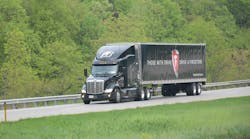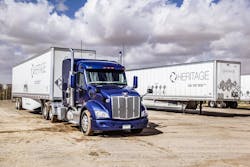When it comes to safety, more private fleets are starting to look for advanced technologies such as lane departure warning and stability control, dash and in-cab cameras along with automatic transmissions, according to Todd Berger, director of national accounts for Paccar Leasing (PacLease).
Truck leasing companies such as PacLease can also offer private fleets new, quality trucks, Berger said, noting that is an advantage that comes with leasing heavy-duty trucks.
According to the National Private Truck Council's 2018 Benchmarking Survey Report, the top safety technologies by private fleets in 2018 are automatic transmissions, speed monitoring, disk brakes and electronic stability control. On the rise over the past year, according to the study, are in-cab cameras, adaptive cruise control, collision warning, and lane departure technologies.
AMT is used in about 80% of the applications Paccar is involved with, Berger said. Fewer than 5% of the trucks it leases are fully manual, he said, with the rest being fully automatic. Fully automatic transmissions “are very expensive compared to the AMT,” Berger said. “Driver fatigue comes in to play. For optimal performance and fuel economy, AMT is a popular choice.”
Delivering freight on time is one of the key things that private fleets can control better than by outsourcing carriers. Findings from the 2018 NPTC study show that nine out of 10 companies (92%) describe customer service as the overriding purpose for having a private fleet. Cost, capacity and control are cited as well as interrelated reasons.
A majority (52%) of private fleets surveyed said that safety is an important part of the customer service value. Shipments (8.3%), volume (2.9%), value (2.9%), and mileage (4.8%) all show increases, but at a slower rate than previous years.
The 100 companies represented in the 2018 benchmarking study are really at the leading edge of the trucking industry,” Petty said. “They are doing so many things on the front lines progressively, technologically, and with safety protocols and management, that we could go on and on talking about their sophisticated levels of management.”
“When you have that kind of momentum,” he continued, “it’s really kind of a special set that’s keen on getting better every year.”
Every one of these private fleet companies, Petty said, is looking at small things that can make the fleet and the company better and move it a little further down the road. This data helps these companies and, in particular, their fleet managers. The benchmarking data can show company executives what is working in the industry, and it can validate what a private fleet is already doing, thus justifying the investment in their equipment, their drivers, their technicians, and their fleet support staff.
Here are some more NPTC 2018 Benchmarking Survey insights:
- More than 200,000 companies, excluding farmers, operate private fleets.
- Private fleet outbound freight market share is 68%.
- 52% of private fleet Class 8 trucks are leased, up from 46% in 2017.
- 84% of private fleets are involved some sort of “green” initiative, down from 87% in 2017.
- In 2018, there is a 3.54 trailer-to-tractor ratio among private fleets, down from 4.2 in 2017.
- Private fleets reported a 15.4% driver turnover rate this year, about even with 15.2% in 2017.
- The average driver age is 50.4 years old for private fleets, the same as it was in 2017.
- 61.8% of private fleet drivers are home every night, similar to 2017 numbers.
- 20.6% of private fleet drivers are out two nights or more per run in 2018.
- 32% of private fleets have a driver union presence.
- Private fleet drivers average $67,869 in annual salary, down slightly from $68,654 in 2017.
- 86% of private fleets have a driver wellness program.
- Private fleets reported a DOT Recordable crash rate of 0.49 per million miles, a decrease from 2017’s 0.61.
- 44% of private fleets report using both forward- and driver-facing cameras.





